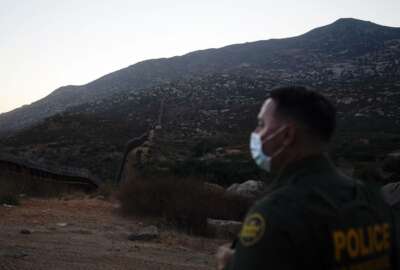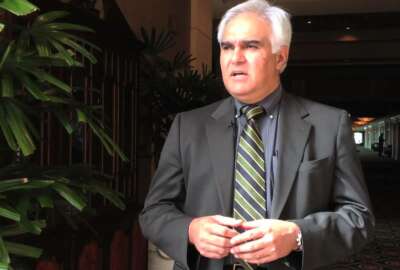
Customs and Border Protection creates a mobile app for mobile people
Tricia Kennedy and Sunil Madhugiri, of Customs and Border Protection, joined Federal Drive with Tom Temin with a more detailed description.
Best listening experience is on Chrome, Firefox or Safari. Subscribe to Federal Drive’s daily audio interviews on Apple Podcasts or PodcastOne.
Customs and Border Protection deals with the world when it’s on the move. Now it has a mobile app to help travelers to the United States deal with their documents and figuring out what services or information they need for arrival and departure. Tricia Kennedy, a CBP officer assigned to its Innovation Center, and Sunil Madhugiri, acting chief technology officer, joined Federal Drive with Tom Temin with a more detailed description.
Interview transcript:
Tom Temin: Tell us who in the public that you deal with is this app aimed at?
Tricia Kennedy: The CBP One mobile application will be for travelers arriving [at] airports, seaports and land borders. At the same time, this CBP One mobile app is an overarching app, so it’s also for CBP stakeholders. And CBP stakeholders can be brokers, airline carriers, commercial vessels, freight forwarders, and bus operators. One of the reasons why we made it overarching is because stakeholders are typically travelers and vice versa.
Tom Temin: And this is foreign travelers coming to the United States, or is it also for US people that leave and come back?
Tricia Kennedy: So currently it is for a foreign traveler, but in the next several months, this app will be available for any travelers coming into the United States.
Tom Temin: All right, and what types of services do you offer through the app? What do people do with it?
Tricia Kennedy: Currently, the CBP One app is available for foreign nationals who require an I94 form. And an I94 form is an arrival/departure form, which confirms that the foreign visitor has been lawfully admitted into the United States. It gives them visa information and also says how long they’re allowed to stay in the United States. So these travelers can apply for and pay for this form, in advance. And then once the I94 form is issued at the port of entry, they have immediate access on their handheld device to the electronic form. They know exactly how long they have left to stay in the United States, and they can provide that information to anyone who might require it.
Tom Temin: So that is to say they come through the checkpoint, say at Philadelphia or New York, wherever it might be, and the documentation is ready on their phone.
Tricia Kennedy: Exactly. And one of our biggest benefits is, if you pay for an apply in advance, you can have this form issued to you on your initial encounter with CBP. If you do not prepare yourself in advance, you’ll have to be referred to a secondary area for additional processing. So as long as you prepare in advance, you can get through the CBP process much quicker, which also helps US citizens and other travelers because as we get these travelers out of the secondary processing area, it’s much quicker for everyone else to get processed as well.
Tom Temin: Yeah, you guys are making it so fast, people are out an hour before the luggage comes out. That’s the problem nowadays. And Sunil, what are the types of data sources and backend kind of integration that had to happen to enable this?
Sunil Madhugiri: Yeah, absolutely. So to Tricia’s point, you know, this is a very important application our travelers are using, especially coming from overseas. So the data component is important, because what we have done is if you look at the application, as per se, it’s developed with an application called Flutter. And it has two components to it: It has a front end and a back end like any other program. It’s also very secure. Let’s start with the back end first. So the back end perspective, we have like one core base. This code base, as you can imagine, the two important applications which we folks download is one for iOS and Android. So both are supported and we download from any of those app stores. And from back end perspective is currently, we are using Java Spring Boot, and – which is a common technology a lot of folks are using it across the board. The important thing is that our developers are, who are experts in Java Spring Boot, and you know, some other like Node.js and things like that, those components, what was being developed, is that it’s all generic, is open source to certain extent, right, but also is secure. So what we made sure is security and privacy, the information of other travelers is number one for us, right? So everything is completely secure. But you’re downloading it, you’re going into an application, which is a download to your phone. You can earn two ways: you could render the application through using a URL. So – is not very secure, but giving an application, which is an app running on your phone, you can get more feature functionality out of that. Plus also it will be more secure, and it’ll help us for the traveling public.
Tom Temin: We’re speaking with Sunil Madhugiri, he is the acting chief technology officer. And Tricia Kennedy is a Customs and Border Patrol officer assigned to the Innovation Center, both with the CBP. What about languages available on the app, because it is for foreign travelers coming to the United States?
Tricia Kennedy: We will definitely offer different languages, this specific type of language is going to be specific to the capability we’re talking about. So for example, if that capability is primarily going to be utilized on the northern border, we would certainly have both English and French. if it’s a capability primarily on the southern border, we would absolutely have Spanish available. So the entire app is not multilingual. But as you go into each capability, the appropriate language for that capability will be available.
Tom Temin: And I’m wondering, in the larger sense, having a data-based approach to all of the services and documents that people need, an information – can that over time help CBP manage the border process more efficiently with information about patterns or that type of thing?
Tricia Kennedy: Absolutely. So you mentioned that we’re already doing things quickly. But you can never process quickly enough, especially from the perspective of the traveler. But from the CBP perspective, we can never have enough information. And we can never have enough time to analyze that information. So the more we get, and the earlier we get it, it makes us much more effective in making those analyses and identifying those travelers who really don’t need a lot of time with CBP, but also those travelers that we might want to spend a little extra time with.
Tom Temin: And you mentioned also, there are people like shippers that might use this or in the cargo setting, as opposed to the passenger airline setting, or the transportation employees of foreign carriers and that kind of stuff. Are they, different cases than the average tourist that might want to go see the Statue of Liberty?
Tricia Kennedy: Absolutely. So they are travelers, but we also have ways that they can conduct a business with the CBP One application. In particular, currently, we have an application for brokers, air carriers, and freight forwarders to schedule inspections of perishable cargo with us. And the reason we started with perishable cargo is it’s a just-in-time environment. They need these inspections quickly and they need to get that cargo to local businesses or throughout the U.S. to those businesses. So they need quick and effective communication, which typically occurred through emails and telephone calls. Now, as they’re in the field, they can request this inspection on their phone. And CBP provides live status updates, live chats. They can be in constant communication with CBP and feel secure, that their inspection is going to be complete.
Tom Temin: And Sunil, was this developed in house by your own programmers? Or did you use a contractor, or how did this all come to be, technically?
Sunil Madhugiri: We have a phenomenal team of engineers who have developed this. Trish mentioned, right, that initially when we started looking at this, this came out of the – community in Miami where the app requirement was that perishable goods are coming in and we want something faster, Trish mentioned, right? So we came up with a pilot program, initially created an app for this, and as time went by, we were improving the application over and over again. And we also followed the agile process, which is an open, a waterfall process – the agile process. We were getting constant feedback from the end user, like Trish mentioned, which is our freight community in this case. And we kept building it and it’s all cloud-based as the cloud hosted. We are very quick, nimble in making changes. And, currently, the app is being used on multiple use cases. And we respond very quickly, not weeks, months, actually in days. So you can imagine how quickly these things are getting built. And everything’s being built in-house with, and our our trusted partner in the in this case is Trish and team from [the Office of Field Operations]. We work very closely with them. And we have made it flexible enough, the architectures as new features come in, we can easily apply those features and deliver to to the field electricians team.
Tom Temin: Sure. And how long has it been out and what has been the uptake of it in terms of downloads, and so on?
Tricia Kennedy: So the app was published to the Apple and Google Play Store at the end of October in 2020. Of course, since we are in a pandemic, the traveler downloads are not quite what we expect. But once travel resumes for nonessential travel, we expect that to significantly increase. But we’re trying to take advantage of this time now to make sure that when travel does resume, we have the best product possible. So right now we have over, I believe 750 downloads. And once travel resumes, we hope to get that to increase significantly.
Tom Temin: Yeah, you’re looking for millions, I guess potentially, correct?
Tricia Kennedy: Absolutely. I just wanted to add one thing on Sunil’s comment about their agile environment – the Agile environment has been incredible, as a customer of theirs, to get this product out to the industry. Government sometimes can deliver products slowly. Their team has been amazing in getting incremental improvements to our customers. We’re not waiting for perfect. We’re waiting to make people’s lives better. And each iteration makes it even better, even better. And then we hope to get to perfect before travel resumes.
Tom Temin: And Sunil, final question for you: Are there elements of the code or of the methodology that you can put, say, in the government’s GitHub instance that might be useful to other federal agencies?
Sunil Madhugiri: Sure. Great question. So you know, we truly believe in sharing as to what we are doing. Especially in CTO office we do have git repositories, where we contribute for public usage. To Tricia’s point, there are certain components of that, or the core thing to that which is more secure with respect to CBP. Those we cannot keep in house, but there’s some generic pieces, especially the front end UI, which is based on Angular, some of those pieces we can share. As to what that looks like, some other end-to-end connectivity, because as you can imagine, these applications or especially these apps, do a bunch of checks and make sure that we are talking to the right people and the right travel and the light importer and things like that. So based on that, we do put stuff out, but we also keep some stuff out because of security and things like that. But we also shared this with, if need be, with the other component within DHS because I know, why recreate something else? And we have done that not only from this application but other applications also where we are sharing code across across DHS, which is going to help or to reduce the time to develop, produce and support the mission.
Tom Temin: Sunil Madhugiri is acting chief technology officer at CBP, thanks so much for joining me.
Sunil Madhugiri: Thank you very much.
Tom Temin: And Tricia Kennedy is a CBP officer assigned to the Innovation Center. Thanks so much.
Tricia Kennedy: Thank you so much. We’re excited to get this out for everyone to use.
Tom Temin: And we’ll post this interview along with a link to more information at FederalNewsNetwork.com/FederalDrive. Hear the Federal Drive on demand. Subscribe at Podcastone or wherever you get your shows.
Copyright © 2025 Federal News Network. All rights reserved. This website is not intended for users located within the European Economic Area.
Tom Temin is host of the Federal Drive and has been providing insight on federal technology and management issues for more than 30 years.
Follow @tteminWFED
Related Stories





